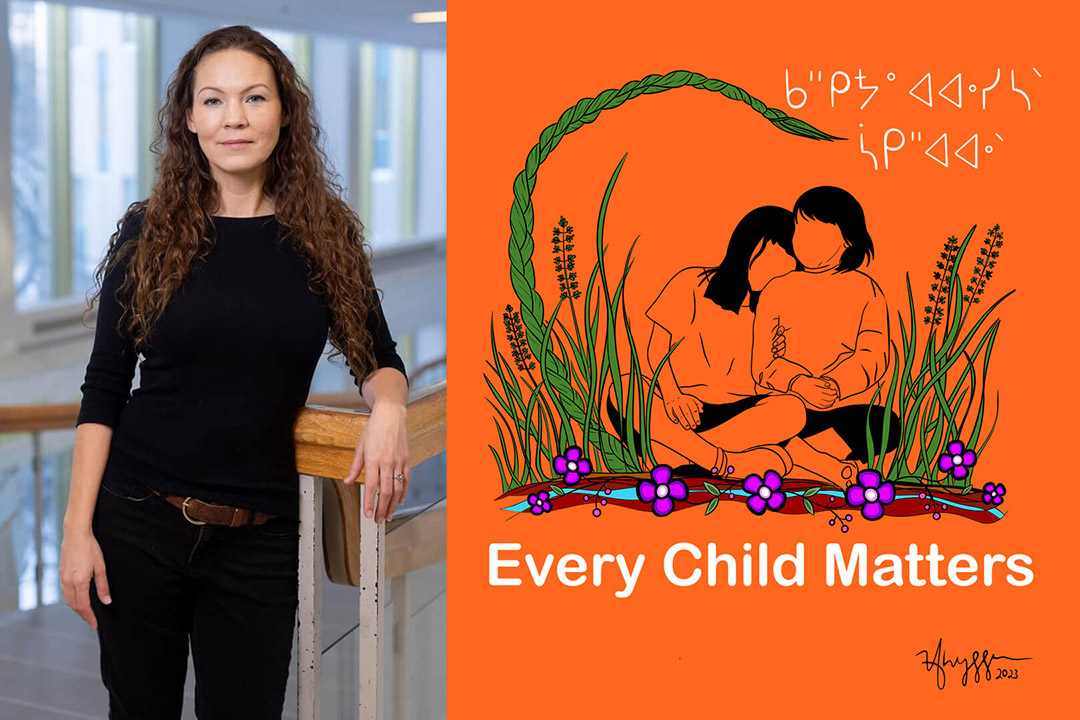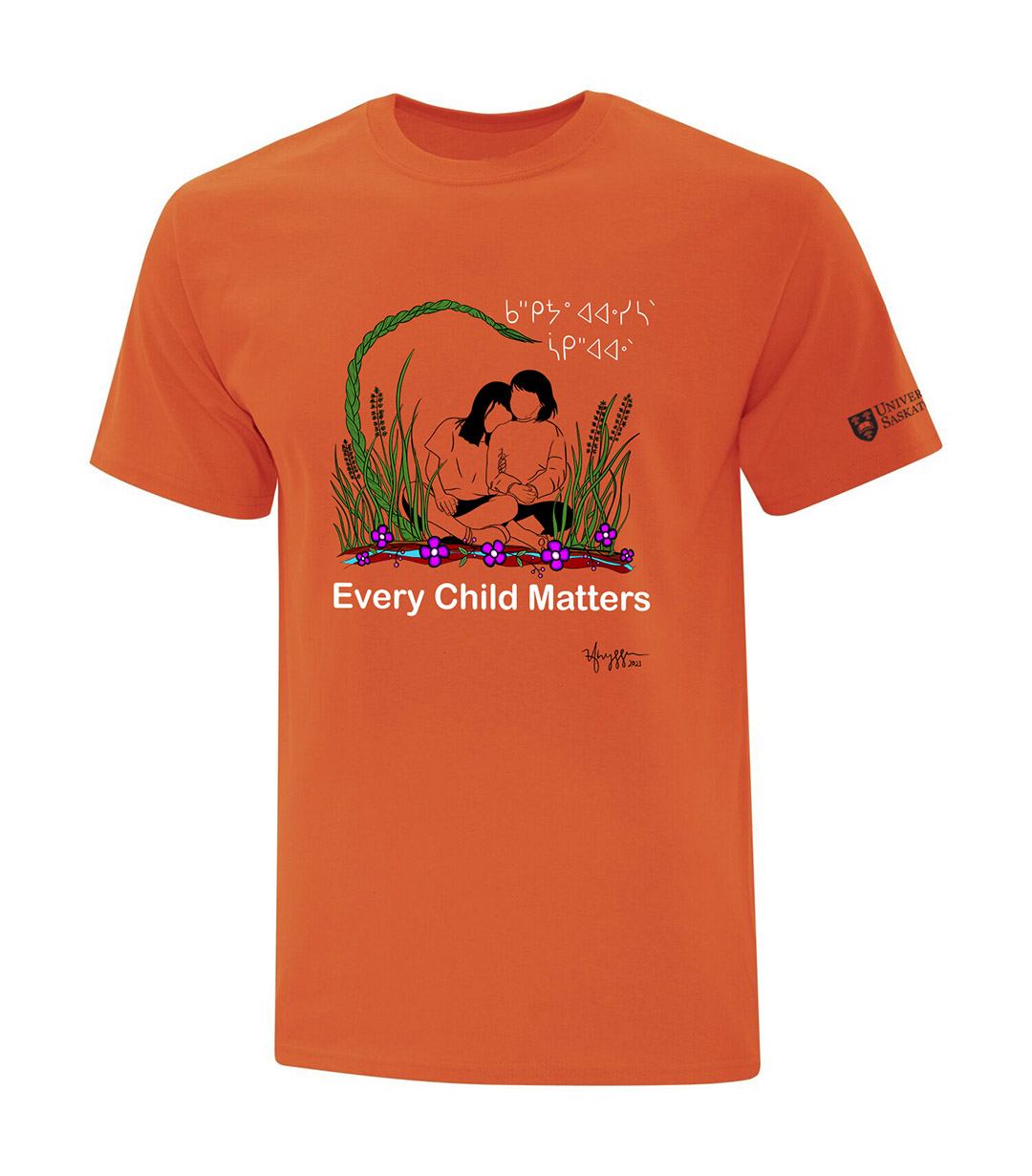
Meet the artist behind the artwork featured on 2023 orange shirts now on sale at USask
For Vanessa Hyggen (BA'17), it’s been a slow and steady path rooted in persistence and collaboration.
To help raise awareness and acknowledge the truth behind the Canadian residential school system, the University of Saskatchewan (USask) Indigenous Space & Visual Symbols in the Health Sciences Committee has partnered once again with Shop USask to provide orange shirts to help acknowledge Orange Shirt Day and the National Day for Truth and Reconciliation on Sept. 30.
Based on a commissioned painting created by Woodland Cree and Norwegian artist Vanessa Hyggen, these shirts will be available through Shop USask beginning Tuesday, Aug. 8.
Vanessa is a Woodland Cree and Norwegian painter and bead artist from nemepith sipihk (Sucker River), in Northern Saskatchewan. She is a member of the Lac La Ronge Indian Band and currently lives in Saskatoon. She earned a Bachelor of Arts with Distinction from the University of Saskatchewan in 2017.
We asked Vanessa about her journey as an artist and why it was important to help create a piece for the USask community to acknowledge Orange Shirt Day.
What is your connection to the University of Saskatchewan?
My mom, brother, sister, and I are all USask alum. My mom was the first in our family to get post-secondary education and now my daughter, nephew, and nieces are all at USask too. I’ve worked in the College of Arts and Science and in the Indian Teacher Education Program (ITEP) as well. I feel very connected to the university and the community.
When did you begin your journey as an artist and how did you get to where you are now?
In high school, I really wanted to be an artist or, at bare minimum, have an art-related career. When I started university, I started out in ITEP thinking I’d focus on being an art teacher. Three years into that degree, I switched gears and decided that my passion was really in creating my own art, so I completed a studio art degree.
It’s been a slow and steady path for me. I was a mom at 19, so my creative time was always after 11 pm. I’ve had lots of small successes as an artist along the way, but it’s been more of a tortoise than hare journey. After I received my first SK Arts grant in 2011, I experienced additional successes. These included my piece, Treaty Annuity, being included in the Indigenous Art Collection of the Government of Canada in 2018 and the opportunity to collaborate with Ruth Cuthand on Beads and Stone (mîkisak ikwa asiniyak in Cree and Lii rasaad aykwa lii rosh in Michif) in 2019.
I think the most important thing that has brought me to where I am now is persistence. It’s important to keep creating and put yourself out there, even though it can feel wearisome at times. I am a bead artist and a painter, but I really love to try new materials and have been getting commissions and contracts that have really been stretching my learning.
I’m excited to take on new challenges and collaboration always proves to be a great teacher!
What influences your work?
My greatest influencer is nature. I am obsessed with light and colour. There really is nothing better than being up north in the shield, canoeing on a perfectly reflective lake or river, soaking in each moss covered stone, every spruce tree reflection, and every sun glint on a paddle ripple alongside your boat.
How do you work? What is your process?
I take tonnes of photos and write lots of notes to myself with my inspirations. Some projects seem more naturally suited to one medium or another so I just dive right in. It’s really just second nature.
What themes do you pursue?
If I’m creating for myself, I most often stick with landscape or representations of nature. I’ve been focusing a lot of my work on Northern Saskatchewan muskegs in hopes of raising public awareness about peat mining. It’s important for me to create work that can help discussions in our communities. If I’m creating for a commission, I’m open to many themes as long as I feel confident in the idea.
What is your dream project?
Great question! I’ve really enjoyed every collaboration I’ve been part of. And recently, I’ve worked in a committee setting, listening to ideas then getting feedback as I create. It’s a pretty interesting way to work and pushes you as an artist. I never had the thought that I’d want to be creating public art, but I have found myself doing just that. I used to really love sculpture in high school and university. So, I don’t know exactly what [my dream project would be] but maybe a big sculpture, created in an interactive way, that lives as a public art piece.
What can you tell us about the painting you created that was reproduced for this year’s orange shirts at USask?
Some of my favourite childhood memories are of being out on the land, playing with my cousins — being free and unencumbered as childhood should be. This painting represents that feeling of love and safety. The Cree syllabics say kakithaw awâsisak sâkihâwak, meaning every child is loved. The sweetgrass shelters the children and represents not only the teachings of sweetgrass, but also our living culture and medicines, which bring healing and goodness.
Why was it important for you to help create a piece for the USask community to acknowledge Orange Shirt Day?
There’s a meme that’s been going around for a couple years that says, every Indigenous person you know is either a survivor of residential school, a child of a survivor, a grandchild of a survivor – or all three. And it’s true. I remember talking about residential school when I was in elementary school in Saskatoon and none of my peers knew what I was talking about. My grandparents passed away before the Truth and Reconciliation Commission began and, even though they never got to tell their stories, the effects are still present in our lives.
I’m glad that people are learning now — but we still have a long way to go and Orange Shirt Day is a great contribution to that learning.

Proceeds from the sales of shirts featuring Vanessa’s artwork will be directed toward a fund supporting the implementation of the Truth and Reconciliation Commission’s Calls to Action with a portion of proceeds also being directed toward the artist.
To order an orange shirt from Shop USask, visit https://shop.usask.ca/orange-shirt-day
- Group/department orders of 20 or more are eligible to receive a 10% discount and should be placed no later than Aug. 25 to help ensure timely delivery.
To learn more about Orange Shirt Day, the Canadian residential school system and other important topics, please visit the links below:
- Learn about Indigenization, decolonization, and the history of Indigenous Peoples and cultures through the Office of the Vice-Provost Indigenous Engagement (OVPIE) website and the University Library’s I-Portal: Indigenous Studies Portal
- OrangeShirtDay.org
- Every Child Matters: Truth – Act One and Every Child Matters: Reconciliation – Act Two (via The National Centre for Truth and Reconciliation)
- The night Edmonton residential school students fought back (video via CBC News: The National)
- History of Residential Schools in Canada (via Canadian Geographic Indigenous Peoples Atlas of Canada)
- ‘Cultural genocide’: the shameful history of Canada’s residential schools – mapped (via The Guardian)
- Residential Schools in Canada: A Timeline (video via Historic Canada)
- Stolen Children | Residential School survivors speak out (video via CBC News: The National)
- Truth and Reconciliation Commission of Canada (Government of Canada)
For emotional crisis referral services and information on other health supports from the Government of Canada, residential school survivors can call 1-866-925-4419.
The University of Saskatchewan community is encouraged to access support services through Student Affairs and Outreach by calling (306) 966-5757 or emailing intake@usask.ca.
The Hope for Wellness Help Line is also available to Indigenous peoples across Canada 24 hours a day, 7 days a week for counselling and crisis intervention. Toll-free at 1-855-242-3310 or available via online chat at hopeforwellness.ca.
Together, we will work towards Truth and Reconciliation. We invite you to join by supporting Indigenous achievement at USask.

